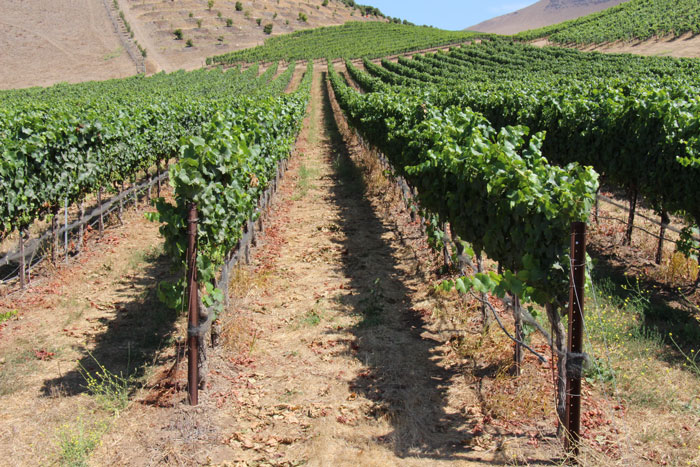
Handy tools for matching available soil water to vine needs
“Overall, soil water content is highly correlated with midday leaf-water potential.” Zhuang says. “Growers can use soil and vine measurements to validate irrigation scheduling based on experience and visual observation.”

The wide variation in water use by grape vines throughout the season complicates the challenge of providing vines no more water than needed and only when they need it. That task has become even more critical now as supplies of irrigation water continue to dwindle and irrigation costs keep rising.
University of California studies show that an acre of Thompson Seedless vines with a large canopy, like a cross-arm trellis, uses an estimated 700 to 1,000 gallons of per day during the first two weeks of April. That figure increases steadily until the last half of July when it peaks at about 5,000 gallons or so. Daily water use remains in the 4,400- to, 4,900-gallon range through August before declining to 3,200 gallons by the last week of September.
George Zhuang, University of California Cooperative Extension farm advisor for Fresno County describes three tools that provide immediate readings on either vine water needs or soil moisture levels in the June/July issue of UCCE’s Vit Tips, the San Joaquin Valley Viticulture newsletter.
By determining leaf-water potential, a pressure chamber provides a direct measure of a vine’s water status. This air-tight device applies air pressure to a leaf (or small shoot), where most of the leaf is inside an air-tight chamber, while a small part of the leaf stem (the petiole) extends outside the chamber through a seal.
The amount of pressure required to cause water to appear at the cut surface of the petiole on the outside of the chamber indicates how much tension the leaf is experiencing on its water. A high pressure reading means a high value of tension and a high degree of water stress. Typically, pressure is measured in Bars (1 Bar = 14.5 pounds per square inch).
These measurements are commonly made between 12:30 p.m. to 2:30 p.m., Zhuang notes. “Studies indicate that when midday leaf water potentials decline to -10 bars or less, it is a good time to begin irrigation,” he says. “Measurements made after irrigations have commenced are also useful for monitoring the effectiveness of the irrigation program.”
Two other tools can be used to improve scheduling and monitoring of vineyard irrigation events. To measure water tension, Zhuang recommends placing two tensiometers directly beneath the drip line, side by side and 12 to 18 inches to the side of an emitter. Use one to monitor the 1- to 2-foot depth and the other to measure moisture 3- to 4-feet deep below the soil surface.
Generally, a pair of tensiometers for every 20 acres is adequate, he notes. However, he advises using more in variable soils.
“Irrigation should be initiated once pre-determined values of soil tension have been reached at the different soil depths,” he says. “Usually, irrigation should begin before soil tensions at about the 2-foot depth approach -40 to -50 centibars. But, irrigation threshold values will depend on soil type.”
Neutron probes can be used to measure total water content of the soil. Two access tubes for this type of device can be placed side by side directly beneath the drip line to a depth of 6 to 9 feet, Zhuang notes. Placing more access tubes between vine rows provides more accurate data on water use by indicating water depletion across the vineyard floor, he notes.
Irrigation should start when the soil allowable depletion is less than the difference between neutron probe measurements and soil water-holding capacity, he says. Soil allowable depletion can vary from 1.4 inches in sandy soils to 4.4 inches in clay.
“Overall, soil water content is highly correlated with midday leaf-water potential.” Zhuang says. “Growers can use soil and vine measurements to validate irrigation scheduling based on experience and visual observation.”
About the Author(s)
You May Also Like



